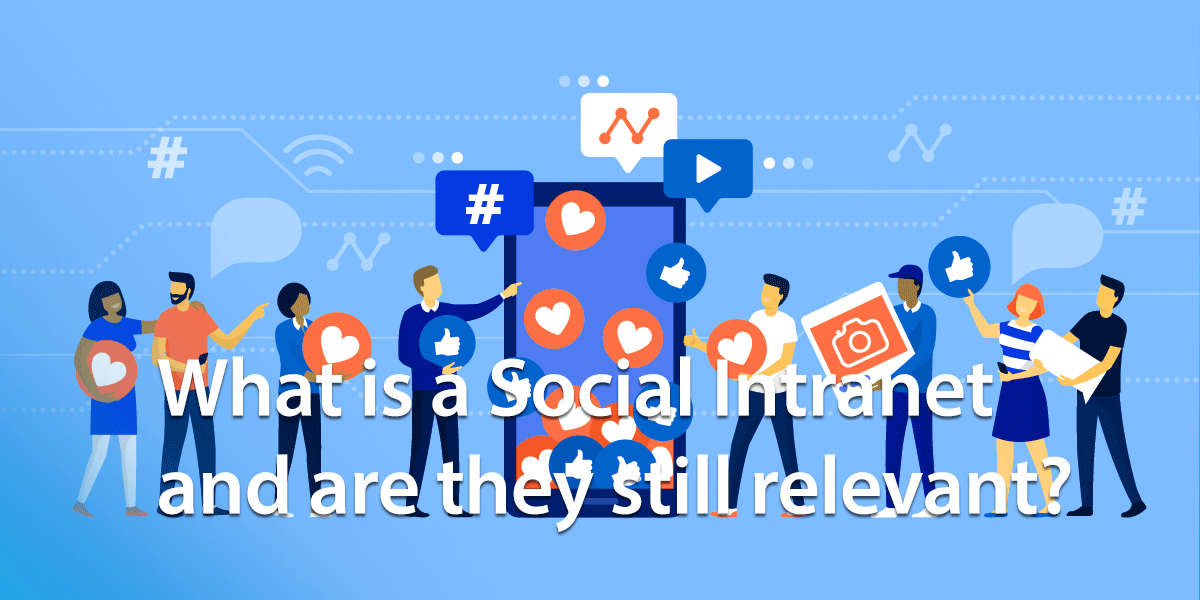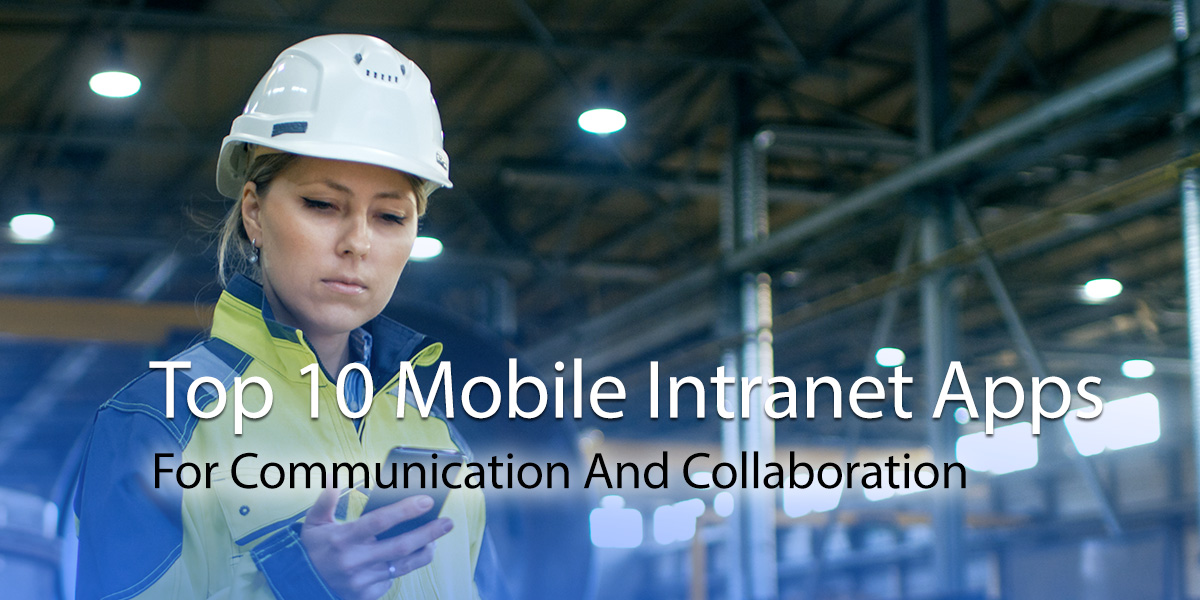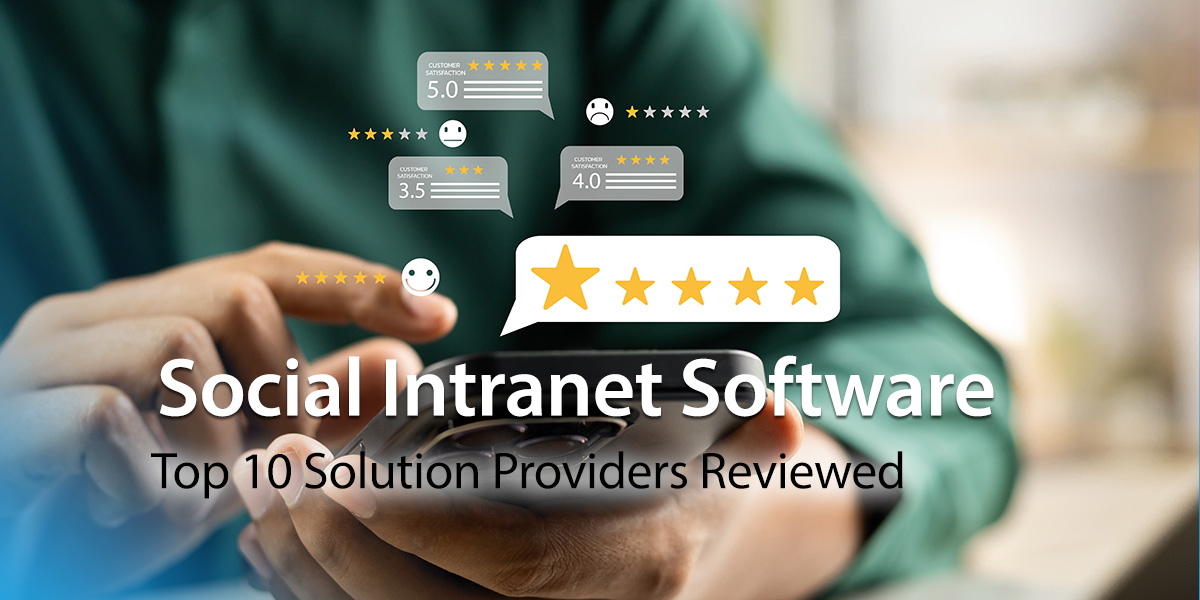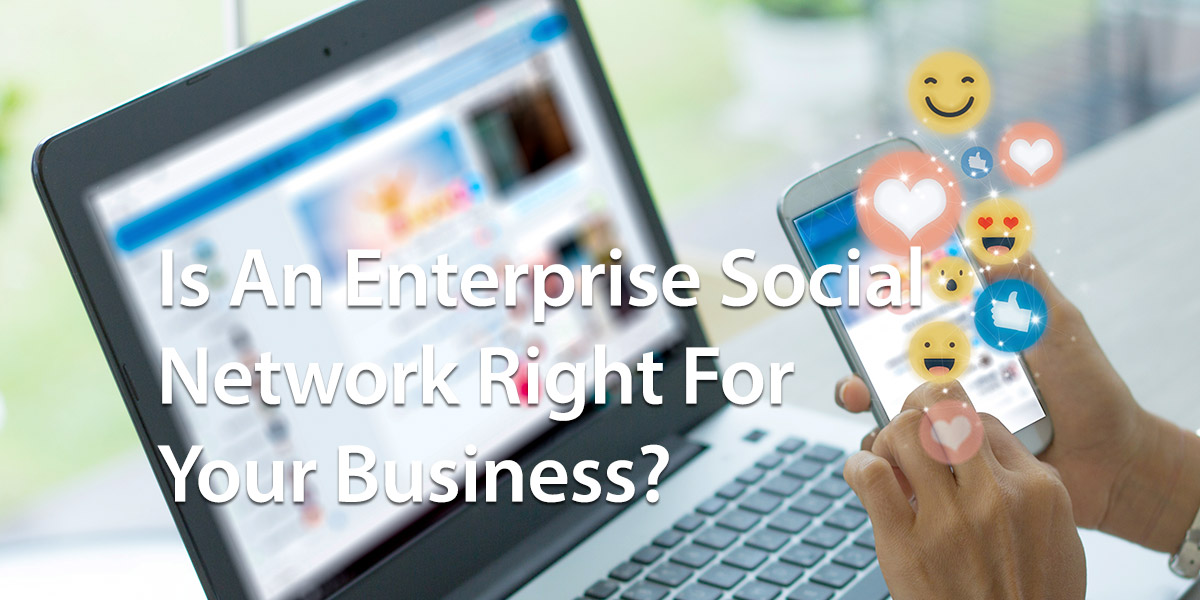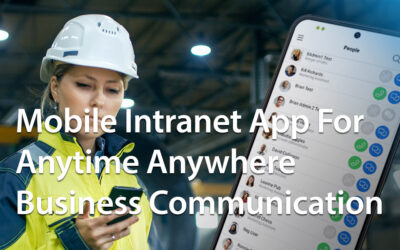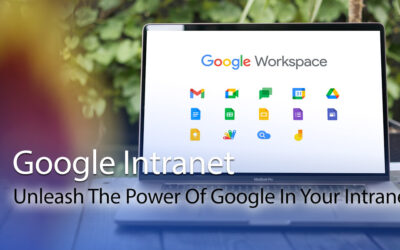Social intranets have taken the world of employee communication by storm. With flexible working arrangements, hybrid workforces, and mobile computing the norm, it’s no wonder social intranet software is at the digital workplace epicenter. More importantly, the employee social network features now found within the modern intranet – such as instant messaging, activity feeds, forums, likes, emojis, comments, and more – have been shown to enhance culture, boost morale and increase engagement.
It’s widely accepted that the popularity of social networking sites (for personal use) has caused this cross-over into the business world. According to the latest data, 59 percent of the world’s population uses social networking sites. Yet some organizations still question whether a modern social intranet will increase productivity. Their concern is that it encourages employees to waste time on idle chat and non-work activities.
Today’s post seeks to answer the question on the lips of many executives: Is a social intranet solution right in every digital workplace?
- What Is A Social Intranet?
- Why Is A Social Intranet Important?
- How To Engage Staff With Your Social Intranet
- Recreating The Social Intranet Experience For All
- Social Intranets In Action: How Companies Are Using Them In Practice
- Best Intranet Software Must-Have Features
- How To Select The Best Social Intranet Software: Bonus Tips
- Social Intranets: A New Narrative
What Is A Social Intranet?
Let’s start with a definition. Mention the word ‘social,’ and most of us automatically think of the likes of Facebook, Instagram, and Twitter. We all use these platforms to connect with family and friends by sharing news and updates. So, what exactly is a social intranet?
“A social intranet performs the same functions as social media applications in the workplace. It’s an internal communications and employee collaboration platform which helps employees connect and build relationships. Social intranet software encourages information sharing, interactions between colleagues, and working together on common goals.”
What Are The Main Features Of A Social Intranet?
There are two standout features. First is user-generated content. All employees can create relevant content. It could be commenting on a news item or corporate blog. It might be contributing insights to a company forum or updating an activity wall. The critical point here is that every employee can participate equally.
Secondly, social intranet platforms are designed around people rather than content. This people-centric approach means every piece of content is somehow connected to an individual worker. Therefore, employees can build connections more meaningfully than is possible with corporate-generated content. The big advantage of this approach is that all employees have a stake in the company intranet. And there’s a collective responsibility to keep information relevant and current. And perhaps most important of all, workers can bring content to the attention of those who need it.
What features would you expect to see in a social intranet? There are a ton of fantastic modules to choose from. And the good news is that you can select those that are appropriate to match your business requirements, including the following:
- Corporate and team newsfeeds
- Notifications, tags, @mentions, and push notifications
- Instant messaging with # channels
- Team or individual activity walls
- Quizzes and surveys
- File and document sharing
- Follow-me functionality
- Private and public discussion forums and collaboration features
- Centralized knowledge base for all company resources
- Staff directory with employee profiles.
And all of this great functionality is supported by powerful search capabilities. Workers can quickly and easily source data and information, improving efficiency and saving time.
Furthermore, your social intranet platform integrates with external enterprise software. It could be embedded Google Workspace or Microsoft 365 apps, HR platforms, and CRM systems such as Salesforce. The software provides seamless access to these third-party apps with single-sign-on synchronization. Do away with multiple logins and several open screens. Modern intranets provide gateway access to all your organization’s critical enterprise apps.
Why Is A Social Intranet Important?
Workplaces have always been social. After all, a strong corporate culture is built on social relationships. Whether formal project meetings or casual conversations around the coffee machine, we have all been social networking for years. However, social intranet software has really come into its own following Covid-19 and the shift to remote working. It’s now a mission-critical part of the digital workplace.
Water cooler conversations are trickier when employees are working from any location. Brainstorming new ideas is a challenge in distributed teams. And progressing the corporate marketing strategy when teams are in different states or even countries is problematic. And that’s not to mention what CNN has dubbed the dark side of working from home: loneliness and isolation. It’s estimated that up to 20 percent of remote workers are struggling with loneliness. And this has a severe impact on job performance and overall productivity. Community interaction, connections with colleagues, and feeling part of a bigger picture are essential to high-performing workplaces.
Now more so than ever. It’s part and parcel of a positive employee experience. However, executives are often skeptical about workplace social networking. Far from being an essential workplace tool, business leaders sometimes see social intranets as a time-waster. So, what’s the truth?
Social Intranet Software: A Time-Waster or Productivity Catalyst?
Creating a ‘social’ environment undoubtedly carries a negative connotation to some. Many managers think I want my employees to be more productive, not socialize more. A common issue for managers is that employees will waste time posting photos and chatting about shared interests unrelated to work. However, many leaders now realize that creating an environment where people can easily share opinions and ideas on a range of projects and subjects is far more beneficial. Does it matter if there are some minor emoji distractions along the way?
Research backs up the idea that social intranet software increases productivity. Data from Gallup found that social engagement increased productivity at the lowest cost. Social intranets offer fertile ground for employees to share ideas instantly, receive project updates, and coordinate responsibilities on a single platform. Time-wasting tasks such as searching for meeting notes, emailed status reports, or written feedback are a thing of the past. The result is an environment where ideas spread, and projects advance more quickly.
Social intranet software powers up collaboration. A centralized, accessible platform dedicated to communication empowers employees to contribute ideas and feel included. Unlike traditional settings where employees exist in information silos, a social environment levels the playing field. It encourages employees at all levels to contribute, increasing innovation and productivity while discouraging micromanaging.
In short, it empowers your people to get involved, so that you can access their collective creativity. As for the worry that employees will waste time socializing, intranets have integrated engagement analytics. You can monitor how the software is used and take steps to tackle inappropriate or time-wasting activities. However, don’t discourage all personal sharing.
Sharing some personal information is essential to building trust and camaraderie. Forbes discussed a report that focused on the importance of socially engaged employees. Researchers found that 59 percent of engaged employees used social media to build relationships within the company. Those employees were more likely to feel proud of their workmates and the company’s leadership. They concluded:
“Social media engagement contributes to a competitive advantage, with the most engaged companies prevailing in the never-ending battle to recruit and retain top talent.”
Social Interaction: With Your Blessing (Or Without)
The bottom line is that social interaction is positive in the workplace. Building personal relationships results in better collaboration and more loyalty. Think of it as a shift in communication style. Baby boomers built relationships around the water cooler. Millennials are building relationships through an enterprise social network. So, why not provide a secure, centralized platform for them to do so? If you’re on the fence about implementing a group intranet, consider this.
If you don’t provide an official company social intranet, workers will use any of the many, many external social tools available. Your employees are probably already using social platforms to make their jobs easier, such as WhatsApp, LinkedIn, or Zoom. And managing multiple platforms and logins will hinder productivity and decrease security. Instead, keep control of company conversations by having them on your own monitored social network.
The Benefits Of A Social Intranet Don’t Discriminate
The case to implement social intranet software for large corporations with hundreds of employees makes sense. But do small organizations really need to invest in an intranet solution? Research firm Nielsen Norman Group answered this question as follows:
“Small organizations with a stable employee base, systemized storage of information and policies, and a workforce that communicates and collaborates easily may not need to invest in an intranet… yet. But even small organizations rapidly outgrow email, social feeds, and file sharing solutions.”
So, even if your business is in perfect running order right now, your needs will change as you grow. As a result, small to medium-sized enterprises are turning to cloud solutions that can grow with them.
The benefits of social intranets go far beyond bringing employees together. Even with a few employees, a modern social intranet improves internal communication. It also addresses challenges associated with file sharing, working remotely, and clogged email inboxes.
Small businesses with multiple locations or expansion plans should prepare now. A social intranet provides the perfect tool to link employees working from anywhere, regardless of company size. And the benefits extend outside the white-collar office setting. Imagine blue-collar workers in the field with a constant line of communication to the office. Say a technician is having difficulty with a particular job. He can easily ask for assistance from his fellow workers via the intranet’s messenger tool.
It’s no surprise that the most popular social features are messenger apps, blogs, discussion forums, and user comments. And these tools can benefit companies of every size in any sector.
Employee Social Network Simplify Processes
Small business is often hesitant to implement new technology. However, intranet software simplifies business workflows. Think about this quote from Forbes:
“The best social intranet software is not the one providing the most social features, but the one which ties the most business processes and data to employees’ social behavior.”
Don’t just think of an intranet as a platform for your employees to interact socially. It also streamlines your workflows. Instead of having multiple communication platforms, digital tools, and document management apps, intranets streamline processes into one network with one login. Wherever employees are, they know exactly where to go to find the answers they need. Remember, being social involves people, your biggest asset.
How To Engage Staff With Your Social Intranet
We live in a socially-connected world. Now, more than ever, workplaces acknowledge this trend and, acting accordingly, implementing social intranets rapidly. Most workplaces rely on their younger staff to be the catalyst for engagement with workplace social platforms.
The benefits are clear. Improving employee engagement, knowledge management, internal communication, and collaboration are just around the corner. However, some businesses fall short, failing to ever get their intranet properly off the ground.
Hello Millennials: A Generation Of Social Media Natives
A generation has grown up living and breathing social digital tools for the first time. Many millennials agree it’s perfectly normal for their relationships to be equally online as in person, for concerts to be seen through a lens rather than through their own eyes, and to spend an evening scrolling instead of chatting. The likes of TikTok and Instagram are deeply integrated into young people’s lives, to the point where it’s an extension of everyday existence. And none more so than millennials. When it comes to championing social intranet engagement in the workplace, millennials are a natural choice. They can encourage older or less digitally inclined employees to get involved, right? This may seem true, but one major issue is that millennials don’t want to.
Why Millennials Don’t Want To Be Your Friend
The underlying issue is that millennials have, until now, regarded social media as personal – and the workplace as professional. 
Millennials have become working professionals and have attempted to draw a distinct line between their personal and professional lives. And unfortunately, all social networking falls outside the professional realm into their private world. Organizations don’t help themselves with their communication around the intranet.
Inevitably, management tries to rally engagement by boiling down the platform to something trendy like ‘Facebook for the company’ or ‘Twitter at work.’ Instantly, this connects Facebook behavior with a workplace setting, which is not desirable in the mind of a millennial. Thoughts rush back to when their friend’s mom tried to ‘friend’ them on Facebook and the immediate self-censorship that it imposes. After all, millennials don’t necessarily want their bosses to know what they had for breakfast… Or where they partied on a Friday night.
Recreating The Social Intranet Experience For All
It’s a matter of telling the right story to generate employee engagement. You can create this narrative by focusing on three key areas:
1. Establishing The Rules Of Engagement
Provide clarity by clearing up the assumptions that employees may or may not have about social intranet usage at work by clearly spelling out how to use it. Rather than let workers walk around on eggshells, articulate upfront what is and isn’t OK to share on the platform.
The main areas to clarify are around confidentiality, external regulations, and formality. The first two areas are relatively straightforward and usually quite industry and organization-specific. For example, you may not be allowed to disclose the details of upcoming tenders to other departments in your business while they are still in an RFP process. Clarifying these expectations is as simple as pulling together straightforward, readable guidelines on what is confidential and what isn’t. And make sure this is common knowledge to the entire workforce.
Striking the right balance of formality and informality is one of those make-or-break areas for your intranet. Our advice is to err towards informal. There’s a time and a place for formal messages and staff memos. A social intranet is about breaking down more rigid structures and allowing communication to flow. Do this, and you’ll get the most creativity and engagement from your workforce.
2. Defining The Purpose
Remember the lens through which staff are viewing the intranet through. For example, millennials won’t inherently know why they should use social intranets. They may assume it is for the same purposes as the likes of Facebook and Twitter and want to steer clear. Or they may think it is for some other work-related purpose that they don’t quite understand and, as a result, don’t engage.
Cast a vision for your teams around the benefits and role of the social platform and ensure that no one misunderstands why it exists in the first place. A few staple benefits of a well-engaged social intranet are improved collaboration, knowledge-sharing, prevention of duplication, increased feeling of connection, more innovation, and employee engagement. Decide which of these is most relevant to your organization and communicate it clearly as the intranet’s purpose. This creates pathways to drive employee engagement.
3. Leading By Example
People do what you do, not what you say. As leaders in your business, engaging in the intranet’s social components and creating the right role model for your people is imperative. Not only does this model appropriate behavior for teams to follow, but it plays to the strengths of cohorts such as millennials. They love engaging with higher-level leaders and want to interact personally with management. By communicating in an informal, personal manner on your intranet, managers lead by example and create an additional incentive to engage more on the platform.
Setting an example can be as simple as leaders sharing stories from their own experiences and giving your people a different insight into the business. For example, imagine the effect on engagement if your CEO was to post a selfie with a client saying, “Just received great feedback from the biggest customer of our service. Well done, everybody! What’s one win you’ve had today?” It’s safe to say that this would drive employees to engage with your social intranet in a productive, appropriate manner.
Social Intranets In Action: How Companies Are Using Them In Practice
As we have seen, social intranets are primarily used to drive internal communications, enhance employee engagement, and spur team collaboration. However, it doesn’t just stop there. Many businesses are using their social intranets in a variety of innovative ways. Here are just a few examples to inspire and motivate you.
Employee Recognition Programs
Many of the best-of-breed platforms incorporate employee recognition programs. Recognizing your employees for a job well done is an easy way to boost morale and employee satisfaction. And a social intranet is perfect for doing just that. It could be a formal employee or team of the month award. However, an informal shoutout to a colleague or peer-to-peer thank you on team chat is just as effective. Whatever form your employee recognition program takes, public acknowledgment on a company-wide platform makes a big difference.
Giving Workers A Voice
Multi-directional communications is the rocket fuel that drives the best-performing companies. The social intranet gives workers a voice, whether top-down, intra-team, or between two colleagues. No one likes to feel invisible. And the great thing about social intranets is that every employee has the same opportunity to engage. This ability helps to remove barriers to communication and collaboration. And it promotes a positive team culture and shared vision. Many businesses find that the employee intranet consequently improves retention and absentee rates.
Speedier Decision-making
Especially in the context of distributed teams, the ability to make swift decisions is a game-changer. And instant messaging via the social intranet is the perfect tool. In one study, 66 percent of respondents said team chat allowed for quick and easy resolution of simple queries. And there are productivity benefits too. In the same survey, 75 percent confirmed that instant messaging reduced time spent on calls and emails.
Knowledge Sharing
Working in hybrid teams makes sharing corporate knowledge a challenge. Back in the physical workplace, we almost take knowledge sharing for granted. There’s plenty of opportunity for connection, interaction, and idea-sharing between colleagues. But not so when staff are geographically dispersed. Messaging via the intranet can help bridge the gap. Consider, for example, the technician out in the field trying to resolve a technical issue. It’s impractical for the service technician to have a detailed operating model for every product. And a social intranet means they don’t have to. A quick instant message to a colleague is often all that’s needed to resolve the problem. Alternatively, a rapid search of the social intranet via a smartphone or tablet provides instant access to a wealth of how-to resources. The technician is more productive, and the customer is happier with the swift customer service.
Employee Profiles
Getting to know colleagues when you don’t share an office isn’t easy. However, the intranet’s user profiles encourage workers to build personal relationships. Alongside professional information such as current projects and corporate knowledge, many businesses also include personal information. A shared interest in scuba diving, home baking, or a baseball team helps build connections between colleagues. And it also makes it easier to identify internal subject experts to consult over a workplace issue. Plus, you can use the employee profile to identify team members for a corporate project.
Onboarding New Employees
Onboarding new staff is tricky when they are working from home. And getting employees up and running as fast as possible is a priority in every business. A social intranet allows you to induct new staff quickly and efficiently regardless of location. Instead of a paper welcome pack, create a virtual one on the social intranet. Buddy the new employee with an experienced colleague on the team chat. And make a #onboarding channel to provide mutual support and speedy resolution of queries. Upload how-to videos, online workflows, and wikis to support the worker in finding their feet. Many businesses have discovered that the social intranet makes the virtual onboarding of new staff a breeze.
Social Intranet Software Must-Have Features
Use the following checklist to ensure that your social intranet solution meets best practices for today’s digital workplace.
Integrations With Third-Party Apps
Your organization already uses several enterprise apps to get stuff done. From CRM platforms to HR management tools, integration allows for seamless connections and data exchange between the intranet platform and other apps. Integrations boost your people’s productivity and efficiency.
Communication, Collaboration, And Knowledge Sharing Tools
This cuts to the very heart of what intranet software is all about. The best intranet software solutions make communication, collaboration, and knowledge sharing easy from any location.
User-Friendly Interface
A modern intranet solution is easy to deploy, simple to manage, and offers a top-notch UX and UI.
Intranet App For Mobile Devices
Mobile access is essential for today’s hybrid workforces. Employees should have convenient access to all the tools needed to support remote and on-the-go productivity.
Analytics
Metrics provide valuable insights into interactions and usage trends, guiding your decision-making and maximizing the performance of your intranet solution.
How To Select The Best Social Intranet Software: Bonus Tips
When it comes to the best intranet software, there’s a lot of choice, right? We round up our extensive discussion with bonus tips on selecting a modern intranet platform perfect for your organization.
Identify Your Must-Haves
Every business is different, so start by compiling a list of your essential features. Perhaps knowledge sharing and internal communication are critical. Others may prioritize employee engagement or project management. Intranet platforms vary, and some will be stronger in some features than others. Furthermore, look carefully at the integrations. Ideally, you want to minimize rather than add to your tech stack.
Intranet Cost
The cost of an intranet varies depending on user numbers, customization, and the selected features. Intranet providers offer various packages at different price points. And so, it pays to compare options and evaluate them against your requirements before signing on the dotted line.
Compare Intranet Providers
Features and cost aren’t the only selection criteria. Just as important are scalability, customization options, and the vendor’s ongoing support. At the end of the day, you want a social intranet that’s easy to set up and manage, scalable, user-friendly, and embraced by employees.
Book A Free Demo
Always take advantage of a trial or, even better, a free demo. It’s the only way to get a feel for how the intranet software might work in your business and whether it’s a good fit.
Social Intranets: A New Narrative
Social media is undoubtedly a powerful influence on today’s society. Businesses need to recognize and harness that power within the workplace. Far from being a time-wasting distraction, the intranet’s social features enhance communications, engagement, and collaboration. Furthermore, the pandemic has drastically altered the workplace. Remote and hybrid working have taken center stage. How will your business respond to these unstoppable trends? A flexible and scalable social intranet could well be the solution your business needs.
What Are The Best Intranet Platforms?
The answer is simple. The best intranet meets your business requirements and improves the employee experience.
MyHub: The #1 Enterprise Social Network
MyHub’s intranet software is at the heart of the digital workplace in businesses worldwide. Organizations use our software to streamline internal communication, drive employee engagement, and connect people to information and each other. Ready to take the next step? Sign up for a free demo or 14-day trial and explore how our modern intranet software can transform your business.

